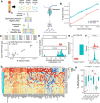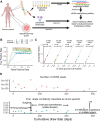Single-molecule methylation profiles of cell-free DNA in cancer with nanopore sequencing
- PMID: 37138315
- PMCID: PMC10155347
- DOI: 10.1186/s13073-023-01178-3
Single-molecule methylation profiles of cell-free DNA in cancer with nanopore sequencing
Abstract
Epigenetic characterization of cell-free DNA (cfDNA) is an emerging approach for detecting and characterizing diseases such as cancer. We developed a strategy using nanopore-based single-molecule sequencing to measure cfDNA methylomes. This approach generated up to 200 million reads for a single cfDNA sample from cancer patients, an order of magnitude improvement over existing nanopore sequencing methods. We developed a single-molecule classifier to determine whether individual reads originated from a tumor or immune cells. Leveraging methylomes of matched tumors and immune cells, we characterized cfDNA methylomes of cancer patients for longitudinal monitoring during treatment.
Keywords: Cell-free DNA; Methylation; Nanopore; Single-molecule sequencing.
© 2023. The Author(s).
Conflict of interest statement
The authors declare that they have no competing interests.
Figures



References
-
- Forshew T, Murtaza M, Parkinson C, Gale D, Tsui DW, Kaper F, Dawson SJ, Piskorz AM, Jimenez-Linan M, Bentley D, et al. Noninvasive identification and monitoring of cancer mutations by targeted deep sequencing of plasma DNA. Sci Transl Med. 2012;4:136ra168. doi: 10.1126/scitranslmed.3003726. - DOI - PubMed
-
- Lo YMD, Han DSC, Jiang P, Chiu RWK: Epigenetics, fragmentomics, and topology of cell-free DNA in liquid biopsies. Science. 2021;372:eaaw3616. - PubMed
Publication types
MeSH terms
Substances
Grants and funding
LinkOut - more resources
Full Text Sources
Other Literature Sources
Medical

